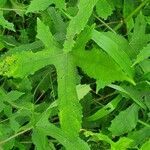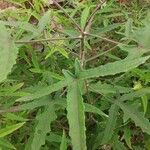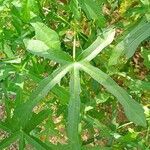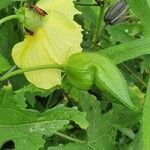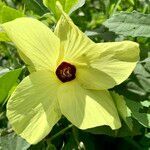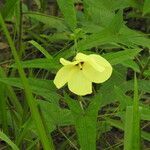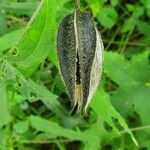Herbs annual or perennial, (0.25-)1-2 m tall, most parts uniformly yellow hispid/setose, rarely glabrous or also pale pubescent, taproot tapered, not swollen. Stipules filiform, 7-8 mm; petiole 7-15 cm, sometimes densely pubescent along adaxial groove; leaf blade 6-15 cm in diam., very variable in form, usually palmately (3-)5-7-lobed, lobes lanceolate to triangular; blades on distal part of stem narrower, both surfaces sparsely hirsute, base cordate, margin irregularly serrate. Flowers solitary, axillary. Pedicel 2-3 cm, hirsute. Epicalyx lobes 6-10, linear to narrowly oblong, (8-)10-13 × 1.5-2 mm, incurved, appressed to capsule. Calyx spatulate, much longer than epicalyx, 2-3 cm, 5-parted, usually caducous, uniformly densely pubescent. Corolla 7-12 cm in diam., yellow with dark purple center; petals obovate. Staminal column ca. 2.5 cm, glabrous. Ovary hairy; style hairy, branches 5; stigma disk-shaped. Capsule oblong, 5-6 cm, apex acute, uniformly yellow hirsute. Seeds black-brown, reniform, concentrically ribbed, glandular-reticulate, with musk smell. Fl. Jun-Oct.
A herb which grows as a perennial. It grows to about 1 m high. The leaf stalk is 7-15 cm long. The leaves are oval with angular edges. The leaf blade is 6-15 cm across. Often the leaves have 5-7 lobes arranged like fingers on a hand. It has Hibiscus-like yellow flowers. There are 5 petals. These have a purple centre. The flowers are 8-10 cm across. The fruit is a capsule 5-6 cm long. It is 5 sided and papery. The seeds are kidney shaped and musky.
